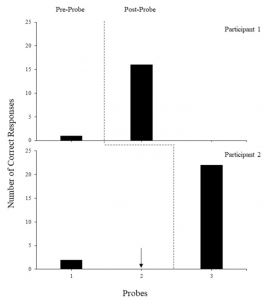A multiple probe design is similar to a multiple baseline design, with fewer measures of behavior. With this design, one can test the effects of a treatment across multiple entities (participants, settings, or behaviors) wherein each entity is probed for a baseline level of responding at least once prior to entering intervention and the start of intervention is staggered across participants, settings, or behaviors.
SCROLL DOWN TO LEARN MORE ABOUT THE DESIGN
Video Instruction
Need to know how to set up the instruction?
More Information about Multiple Probe Designs
 A multiple probe design is a variation on the multiple baseline in which the entities encounter fewer repeated sessions in each condition (see multiple baseline description). Here, all entities participate in an initial pre-intervention probe, providing an opportunity for the researchers to predict how behavior will change after intervention, before entity 1 enters the intervention condition. After entity 1 completes intervention (or a phase of intervention), the behavior of all entities are re-probed (entity 1’s first post-intervention probe and other entities’ second pre-intervention probe). This allows the researchers to demonstrate verification. After this, entity 2 enters intervention, providing an opportunity for the researchers to replicate entity 1’s change in behavior. Graphically, pre-probes and post-probes are separated by a staircase-like condition line across the data panels.
A multiple probe design is a variation on the multiple baseline in which the entities encounter fewer repeated sessions in each condition (see multiple baseline description). Here, all entities participate in an initial pre-intervention probe, providing an opportunity for the researchers to predict how behavior will change after intervention, before entity 1 enters the intervention condition. After entity 1 completes intervention (or a phase of intervention), the behavior of all entities are re-probed (entity 1’s first post-intervention probe and other entities’ second pre-intervention probe). This allows the researchers to demonstrate verification. After this, entity 2 enters intervention, providing an opportunity for the researchers to replicate entity 1’s change in behavior. Graphically, pre-probes and post-probes are separated by a staircase-like condition line across the data panels.